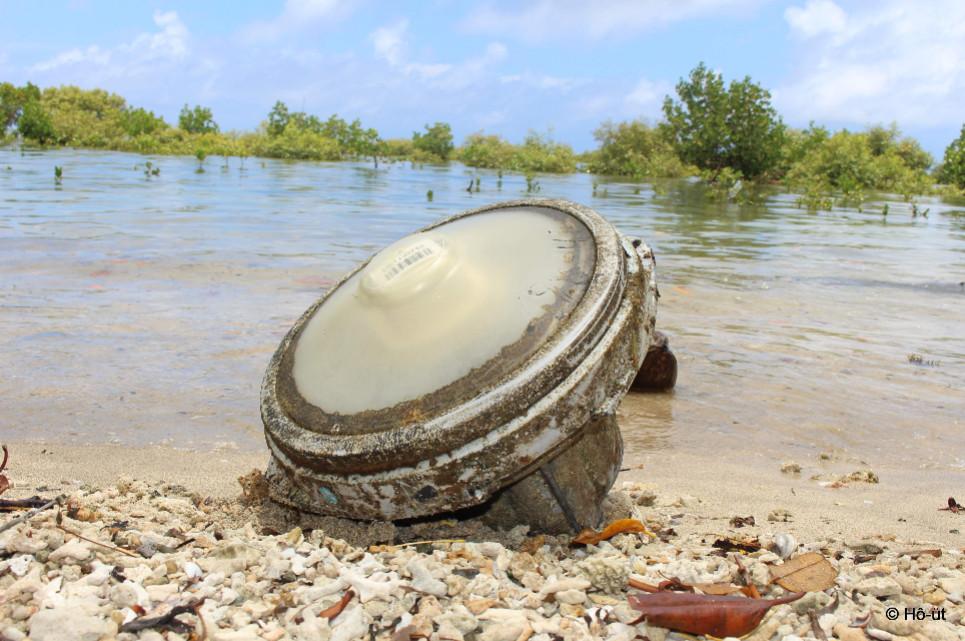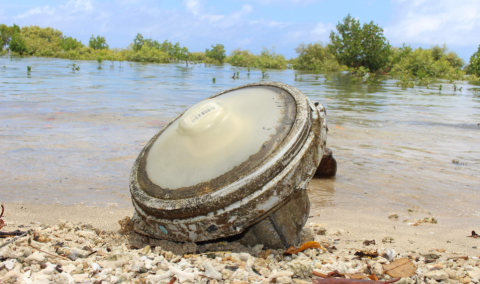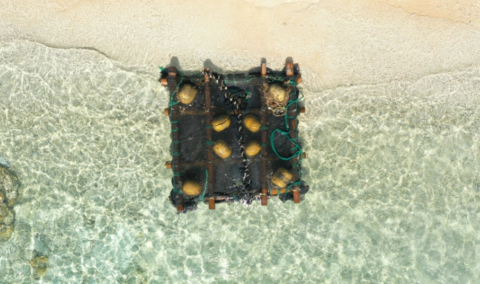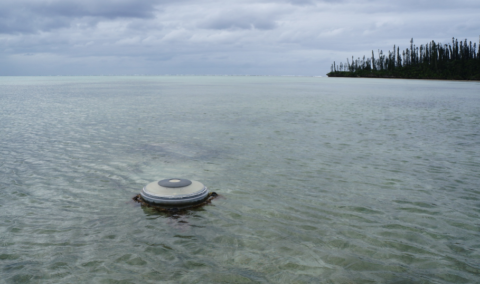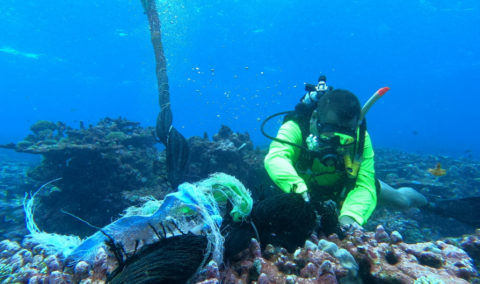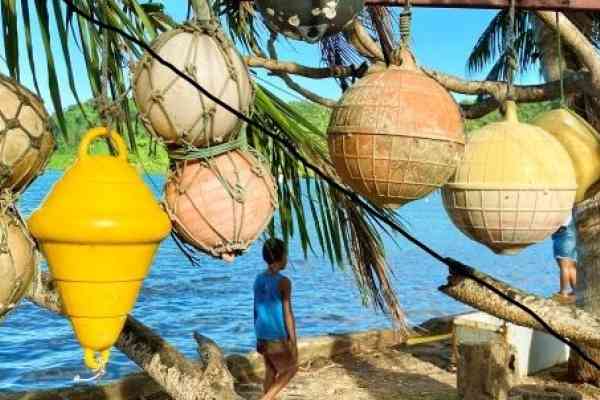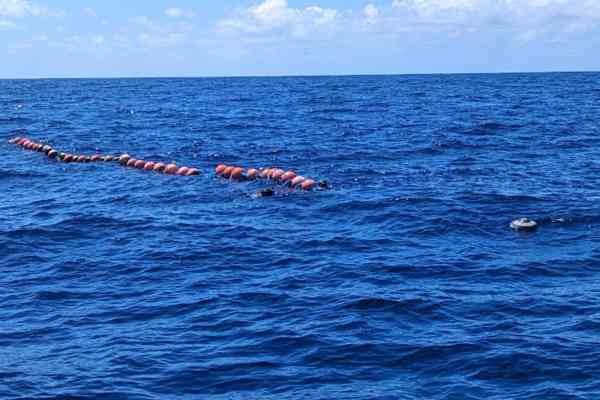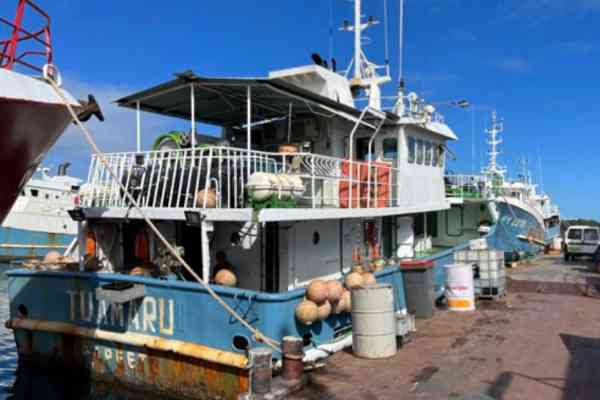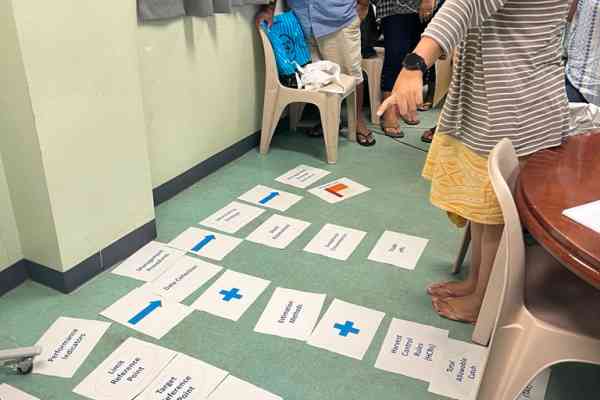Industrial fishing is often singled out when it comes to issues of sustainability and responsible management of natural resources. More and more projects and laws are being put forward to reduce environmental impact and encourage industries to use more responsible practices. Satlink’s Project ReCon, which enables recovered Satlink satellite and echosounder buoys used in the purse seine fishery to be reused, is part of a drive to reduce the impact of this fishery on the environment and to support local communities in the development of local projects. The roots of the project lie in the data collected by the inhabitants of Pacific countries on fish aggregating devices (FADs) stranded in coastal areas.
The western and central Pacific Ocean (WCPO) is the largest tuna fishery in the world and provides half of the global tuna catch (54%) (Williams and Ruaia 2023) using different fishing techniques and for which the purse seine fishery provides 70%. The economic importance of the tuna purse seine fishery to Pacific Island countries and territories (PICTs) cannot be understated, with up to 98% of government revenues coming from fishing licences (Bell et al. 2021).
Extensive use of FADs
In the WCPO, almost half of the catch by the purse seine fishery is made using drifting fish aggregating devices (dFADs) (48% in 2022), while industrial anchored FADs (aFADs) make up roughly 1% of the sets (Williams and Ruaia 2023 Jul). FADs are therefore a key component of the purse seine fishery in the WCPO and worldwide. Recent estimates of dFAD buoy deployments are 30,000–40,000 per year in the WCPO only, and 46,000–65,000 for the whole Pacific (Escalle et al. 2021; Lopez et al. 2021). However, this extensive use leads to several environmental impacts. Abandoned, lost, or otherwise discarded fishing gear is a growing concern for sustainable fisheries in terms of environmental, social and economic impacts (Burt et al. 2020; Gilman et al. 2021; Giskes et al. 2022; Richardson et al. 2019) and represents a substantial part of the global marine debris (10%, according to Macfadyen et al., 2009). In the case of FADs, dedicated assessments of their loss, abandonment and related consequences are still lacking (Macfadyen et al. 2009; Richardson et al. 2019).
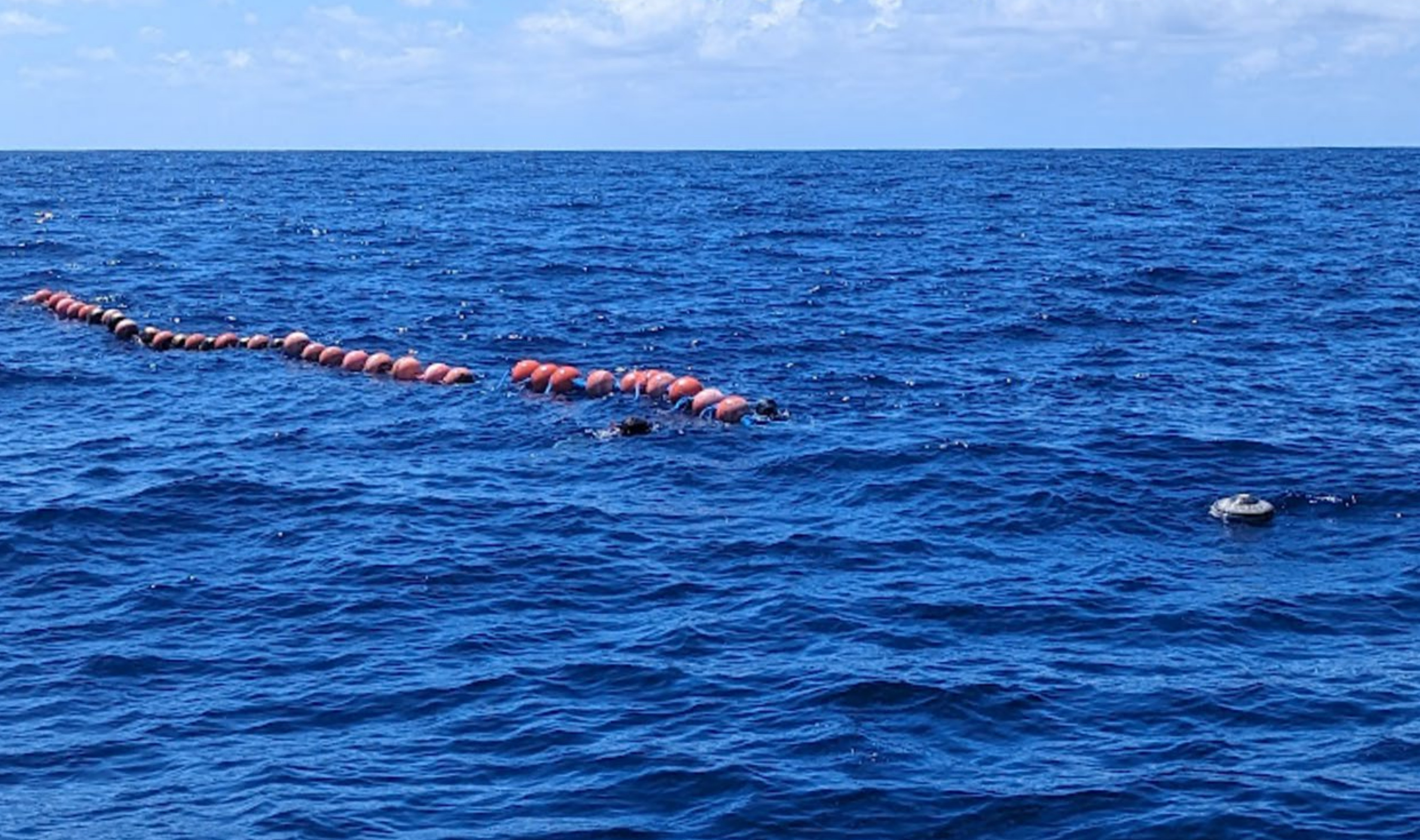
FAD design and environmental impacts
Generally, dFADs consist of a floating raft structure made of bamboo, purse seine float and/or PVC tubes, and are often wrapped up in nets to avoid detection from other vessels. They also have submerged appendages commonly made of old purse seine nets (Abascal et al. 2014; Bromhead et al. 2003; Dagorn et al. 2013) that are used to slow down dFAD drift and create volume to attract fish (Dagorn et al. 2013). In both the raft and the submerged appendages, dFADs commonly include some netting and/or other synthetic materials in their construction (Escalle et al. 2023). Satellite and echosounder buoys are also attached to dFADs, allowing fishermen to track their location and biomass underneath at any given time (Lopez et al. 2014). The extensive use of dFADs and their current design pose serious risks of marine life entanglement of sensitive species such as turtles or sharks, but also threaten fragile ecosystems like coral reefs, benthic habitats and mangroves. Industrial aFADs, on the other hand, are usually a wide metal or fiberglass drum, attached to the sea floor at over 1000 m depth and used in the western part of the WCPO only. While they are deployed in lower number than dFADs, they are commonly lost and, when they reach coastal areas, their stranding events can have large environmental consequences and are very difficult for local communities to remove.
Stranded FADs data collection programmes
With the aim of quantifying the number of FADs (drifting and anchored) reaching coastal areas, strandings, and the impacts they may cause on coastal ecosystems, programmes to collect data on stranding events have been implemented in 11 PICTs (Figure 1 and Table 1): Australia, Cook Islands, Federated States of Micronesia, Hawaii, Marshall Islands, New Caledonia, French Polynesia, Palmyra Atoll, Tonga, Tuvalu, and Wallis and Futuna. These programmes are collaborations between SPC, national fisheries departments, or non-governmental organisations (NGOs). When a FAD and/or satellite buoy is found, a report is made to the local partner who enters the information into a database managed by SPC. They retrieve information on the type of stranding event, the location, the date, the materials present in the case of a FAD and the impacts it has caused. So far, 2,513 stranding events have been reported through these data collection programmes, mostly since 2019, although some programme reports have been made as far back as 2004.
These data-collection programmes on stranded FADs and satellite buoys highlighted that a lot of reports were coming from local communities that have been recovering these objects over several years and sometimes re-using them in their gardens or houses. For PICTs, objects from the sea are often valuable because some materials are hard to find or expensive to import. For instance, electronics and solar panels can be used to make phone chargers, and netting and bamboo can be used to build fences.
![Figure 1. Number of stranding events reported in PICTs involved in the stranded FAD data collection programmes. This area includes the Inter-American Tropical Tuna Commission [IATTC] region.](/sites/default/files/paragraphsimages/2024-03/MicrosoftTeams-image%20%283%29.png)

Project ReCon
In this context, Satlink recently developed Project ReCon, a global circular economy initiative that works with a network of partners and a large part of the fishing industry with the aim of reusing shore-stranded buoys found by local PICT communities. Given SPC’s efforts in collecting data on these stranding events, SPC recently signed on to be a partner for Project ReCon in many of the PICTs in its network. The objective is to mitigate the potential environmental impact and marine pollution caused by buoys that are stranded on shores, far away from the fishing grounds where they were originally deployed. Since many of the buoys found are in good condition and have great potential to be reused in local projects and benefit Pacific communities, through Project ReCon this valuable technology that would have been waste now becomes an asset for the local communities finding them.
When a buoy is found by a community, it is first reported to the local partner, such as the fisheries department or the NGO (Table 2). They then collect information related to the stranding event, including buoy condition. When the buoy is deemed to be in good condition and if the person who found the buoy agrees to give it to the programme for re-use, Satlink liaises with the buoy’s owner to see if they agree to transfer ownership of the buoy so that it can be reused in local projects. If ownership is transferred, the local partner and Satlink agree to carry out various tests to assess the state of the buoy’s functions. The buoy can be re-used for its GPS function to track marine debris or the position of an aFAD; its flashing light can mark a channel or a fishing spot; or its echo sounder can be used to estimate the quantity of fish aggregated under a local anchored FAD. Once the tests are complete, there are several possible scenarios:
- If all or some of the functions work correctly, then the buoy is reusable and ready for a second life, provided a local project has a use for it.
- If nothing works, or there is no project available, then Satlink and SPC will work together to find the best way to dispose of it responsibly, which could be either through a local channel if one exists, or by sending it to Satlink’s head office in Spain so that all the components can be recycled.
Figure 2. Photos of stranded FADs and/or buoys (© Federated States of Micronesia, French Polynesia and New Caledonia databases).
New Caledonia – case study
In New Caledonia, a programme to collect data on stranded FADs and satellite buoys has been in place since 2022 in partnership with the Service du Parc Naturel de la Mer de Corail et de la Pêche (SPNMCP) and has collected more than 26 stranded FADs (22 dFADs and 4 aFADs) and 54 stranded buoys. From this programme, five of those recovered so far could be potential candidates for Project ReCon. One of the buoys has just been redeployed on a New Caledonian anchored FAD in December 2023; and a second is likely in the coming weeks. This could have several benefits, direct and indirect, for local communities and fishing associations such as:
i) guaranteeing safe access to food resources,
ii) observing the ocean in real time and contributing to the improvement of forecasting and warning systems for safety at sea, and
iii) observing the effectiveness and effects of aFADs in terms of the concentration of target and by-catch species. In the event of the aFAD becoming detached from its location, the buoy will make it possible to track its GPS position and send an alert to parties onshore. Not only does this limit the environmental impact, but also the cost of manufacturing a brand-new FAD, which can be in the region of more than USD 2500.
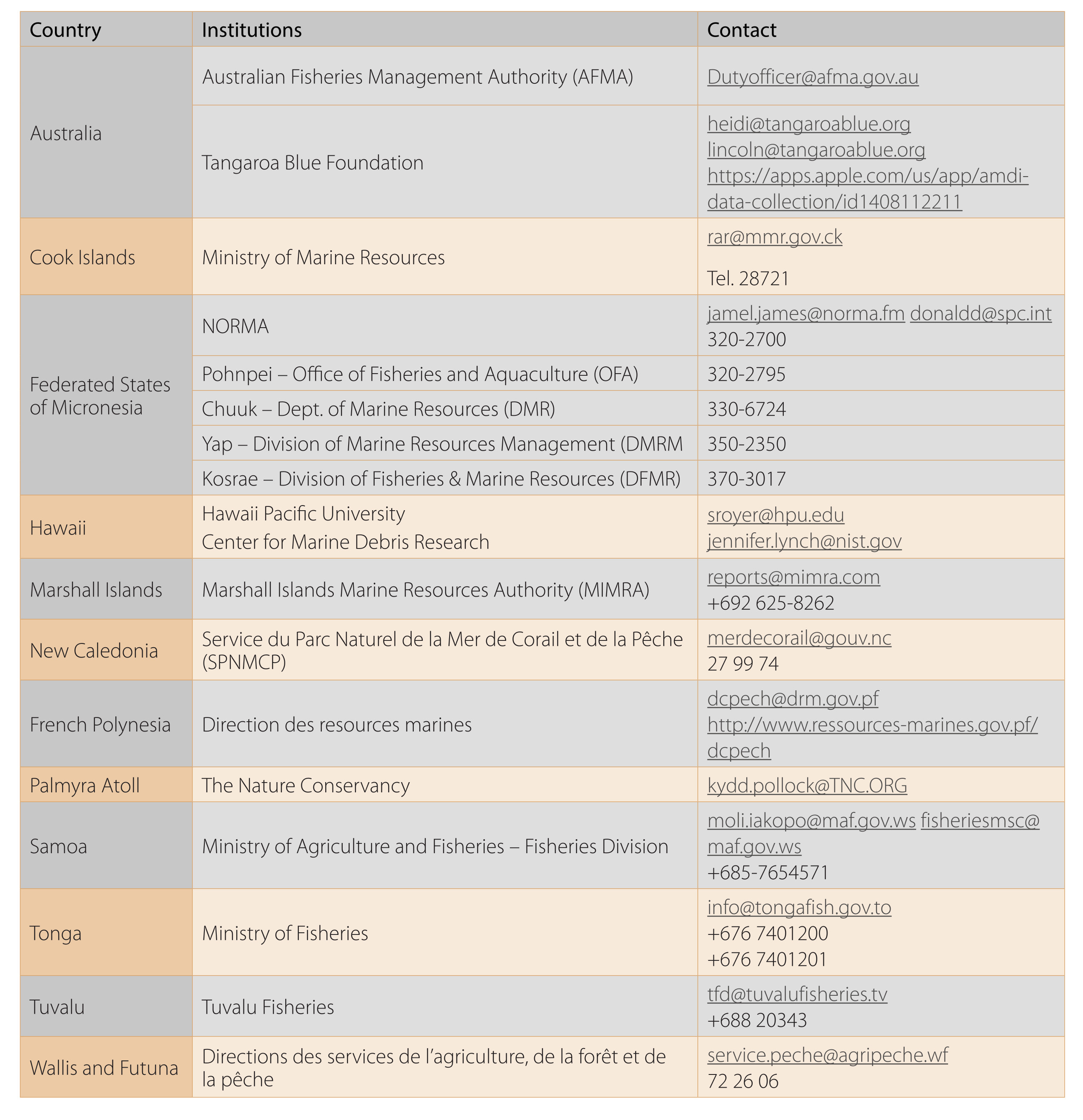
Overall, the current projects have the potential to bridge the gap between high sea tuna fishing and coastal communities throughout the Pacific. First, the data collection programmes provide crucial information about abandoned, lost, or otherwise discarded fishing gear from the tuna fishing industry and the ecosystem impacts that derive from it. Second, through Project ReCon, it reduces coastal pollution and the burden to local communities, while enabling Pacific communities to benefit from it locally. The buoys that are reused support the development of artisanal fisheries and/or conservation projects. Project ReCon develops a circular economy, supports community development and reduces the impact of stranded buoys on Pacific coastlines.
The regional data collection programme is continuing its extension, with a likely start in Papua New Guinea, Samoa and Solomon Islands in 2024. The objective is to have this ongoing programme as a sentinel to monitor FAD loss and associated impacts, while the purse seine fishery evolves with new management measures implemented. Similarly, thanks to the partnership with SPC, Project ReCon will also start in the Federated States of Micronesia, the Cook Islands and the Marshall Islands in the next few weeks, allowing more buoys to be reused through this project.
Contact details for partners involved in the data collection of stranded FADs in several PICTs are shown in Table 2. For PICTs that do not appear in the list, there is no data collection programme implemented yet. However, in case of finding a FAD and/or a buoy, please refer to your fisheries institution or send an email to Jennyfer Mourot (Research Assistant - FADs, [email protected]) or Lauriane Escalle (Senior Fisheries Scientist - FADs, [email protected] ).
References
Abascal F., Fukofuka S., Falasi C., Sharples P. and Williams P. 2014. Preliminary analysis of the Regional Observer Programme data on FAD design. 38.
Bell J.D., Senina I., Adams T., Aumont O., Calmettes B., Clark S., Dessert M., Gehlen M., Gorgues T., Hampton J., Hanich Q., Harden-Davies H., Hare S.R., Holmes G., Lehodey P., Lengaigne M., Mansfield W., Menkes C., Nicol S., Ota Y., Pasisi C., Pilling G., Reid C., Ronneberg E., Gupta A.S., Seto K.L., Smith N., Taei S., Tsamenyi M. and Williams P. 2021. Pathways to sustaining tunadependent Pacific Island economies during climate change. Nature Sustainability. 4(10):900–910. https:// doi.org/10.1038/s41893-021-00745-z.
Bromhead D., Foster J., Attard R., Findlay J. and Kalish J. 2003. A review of the impact of fish aggregating devices (FADs) on tuna fisheries. 122.
Burt A.J., Raguain J., Sanchez C., Brice J., Fleischer-Dogley F., Goldberg R., Talma S., Syposz M., Mahony J., Letori J., Quanz C., Ramkalawan S., Francourt C., Capricieuse I., Antao A., Belle K., Zillhardt T., Moumou J., Roseline M., Bonne J., Marie R., Constance E., Suleman J. and Turnbull L.A. 2020. OPEN The costs of removing. 11.
Dagorn L., Holland K.N., Restrepo V. and Moreno G. 2013. Is it good or bad to fish with FADs? What are the real impacts of the use of drifting FADs on pelagic marine ecosystems? Fish and Fisheries. 14(3):391–415. https://doi. org/10.1111/j.1467-2979.2012.00478.x.
Escalle L., Hare S.R., Vidal T., Brownjohn M., Hamer P. and Pilling G. 2021. Quantifying drifting Fish Aggregating Device use by the world’s largest tuna fishery. Browman H, editor. ICES Journal of Marine Science. 78(7):2432–2447. https://doi.org/10.1093/ icesjms/fsab116.
Escalle L., Mourot J., Hamer P., Hare S.R., Phillip N.B. and Pilling G.M. 2023. Towards non-entangling and biodegradable drifting fish aggregating devices – Baselines and transition in the world’s largest tuna purse seine fishery. Marine Policy. 149:105500. https:// doi.org/10.1016/j.marpol.2023.105500.
Gilman E., Musyl M., Suuronen P., Chaloupka M., Gorgin S., Wilson J. and Kuczenski B. 2021. Highest risk abandoned, lost and discarded fishing gear. Scientific Reports. 11(1):7195. https://doi.org/10.1038/ s41598-021-86123-3.
Giskes I., Baziuk J., Pragnell-Raasch H. and Perez Roda A. 2022. Report on good practices to prevent and reduce marine plastic litter from fishing activities. FAO; International Maritime Organization (IMO).
Lopez J., Moreno G., Sancristobal I. and Murua J. 2014. Evolution and current state of the technology of echo-sounder buoys used by Spanish tropical tuna purse seiners in the Atlantic, Indian and Pacific Oceans. Fisheries Research. 155:127–137. https:// doi.org/10.1016/j.fishres.2014.02.033.
Lopez J., Román M.H., Lennert-Cody C.E., Maunder M.N., Vogel N. and Fuller L.M. 2021. Floatingobject fishery indicators: A 2021 report.
Macfadyen G., Capel R. and Huntington T. 2009. Abandoned, lost or otherwise discarded fishing gear. Rome, Italy: FAO, Fisheries and Aquaculture Management Division (FAO Document technique sur les pêches et l’aquaculture).
Richardson K., Hardesty B.D. and Wilcox C. 2019. Estimates of fishing gear loss rates at a global scale: A literature review and meta-analysis. Fish and Fisheries. 20(6):1218–1231. https://doi.org/10.1111/ faf.12407.
Williams P. and Ruaia T. 2023. Overview of tuna fisheries in the western and central Pacific Ocean, including economic conditions - 2022 - WCPFC-SC19-2023/ GN WP-1. WCPFC.
For more information
Jennyfer Mourot, Research Assistant - FADs, SPC | [email protected]
Lauriane Escalle, Senior Fisheries Scientist - FADs, SPC | [email protected]
Download the full SPC Fisheries Newsletter: https://bit.ly/FNL172
